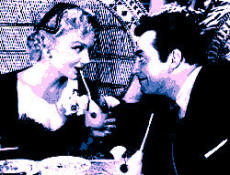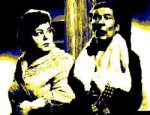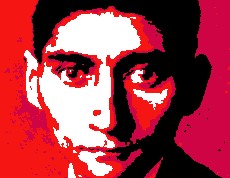Film Review

Despite the lack of resources available to him, to say nothing of the ridiculously tight shooting schedule, Lang was rarely more inspired, nor more imaginative, as he was on this film. Using a new fangled crab dolly, Lang was able to shoot scenes quickly and achieve a remarkable fluidity, with long takes and elegantly crafted sequences that seem to melt into one another to give the impression of an oppressive, unending nightmare. The film's distinctive noir-style cinematography was provided by Nicholas Musuraca, who had previously distinguished himself on such bleakly atmospheric films as Jacques Tourneur's Cat People (1942) and Robert Siodmak's The Spiral Staircase (1945). The most visually striking sequence - the one in which heroine Anne Baxter lunges at an over-sexed Raymond Burr - harks back to the stark expressionism of Lang's early films. We see the attack only fleetingly, reflected in the shattered fragments of a mirror, just as Norah's world suddenly dissolves in confusion.
For the most part, Lang uses more subtle visual cues to add substance and a deeper meaning to the trite plot. Lang's assault on America's cultural decline is more playfully comedic than despairing, evidenced by his canny juxtaposition of Richard Wagner's Liebstod from Tristan und Isolde with Nat King Cole's Blue Gardenia. The musical dichotomy provides not only the key to resolving the murder mystery but also the key to Lang's ambivalence for 1950s America. (Wagner seems a deeply ironic choice for a man who fled Nazi Germany in the 1930s.) Can it be a coincidence that the murder victim is a talented artist who gladly prostitutes his talents for easy celebrity? (You can't help wondering if Lang sees himself in the same light.) And what of the other characters - do any of them have any redeeming features?
Norah's willingness to be deceived by anything in long trousers, even when they are obviously skunks, makes her a pathetic rather than tragic figure, a wry symbol of a society that has lost the wherewithal to recognise moral virtue and attaches too much significance to those things that corrupt and demean the human spirit. Her two female flat mates appear to be almost clones of her - they look the same, have the same appetites, do the same job: production line dolly birds. None of the male characters is shown in a better light - all appear to be cut from the same cloth: opportunistic scoundrels intent only on gratifying their own base needs and advancing their careers. Although the principals Anne Baxter and Richard Conte succeed in making their characters likeable, Lang does his best to show what they really are, and what they truly represent: the superficially attractive face of a decaying society that is in danger of losing its moral compass. It is a theme that the director would develop further, in a far darker vein, in his next film, The Big Heat (1953), the last truly great classic film noir.
© James Travers 2013
The above content is owned by frenchfilms.org and must not be copied.
Film Synopsis
When her fiancé writes her a letter ending their relationship Norah Larkin accepts a dinner date invitation from artist Harry Prebble at the Blue Gardenia night club. In a state of total intoxication, Norah allows the sweet-talking artist to take her back to his apartment. When Prebble makes his move Norah tries to defend herself with a poker, but passes out just as she strikes her assailant. When she comes to in her own apartment Norah has only a hazy recollection of the events of the previous night. From the morning newspaper she learns that Prebble has been murdered, beaten to death with a poker. Casey Mayo, an unscrupulous journalist, takes an interest in the case and soon discovers that Prebble's killer was most probably the woman he was seen dining with at the Blue Gardenia. Mayo publishes a letter in his paper inviting the murderer to come forward, offering her his protection. Convinced of her guilt, Norah hesitates over whether she should take Mayo up on his offer...© James Travers
The above content is owned by frenchfilms.org and must not be copied.
Similar Films
Here are some other films you may enjoy watching:- Merry-Go-Round (1981)
- The Mirror Crack'd (1980)
- A Study in Terror (1965)
- D.O.A. (1950)
- Paranoiac (1963)
Other related links:
Film Credits
- Director: Fritz Lang
- Script: Charles Hoffman, Vera Caspary (story)
- Cinematographer: Nicholas Musuraca
- Music: Raoul Kraushaar
- Cast: Anne Baxter (Norah Larkin), Richard Conte (Casey Mayo), Ann Sothern (Crystal Carpenter), Raymond Burr (Harry Prebble), Jeff Donnell (Sally Ellis), Richard Erdman (Al), George Reeves (Police Capt. Sam Haynes), Ruth Storey (Rose Miller), Ray Walker (Homer), Nat 'King' Cole (Himself), Fay Baker (Switchboard Monitor), Robert Bice (Policeman), Larry J. Blake (Music Shop Clerk), Lela Bliss (Miss Stanley), Gail Bonney (Policewoman), Edward Clark (News Stand Dealer), Mike Donovan (Fingerprint Officer), Frank Ferguson (Drunk Reporter), Sammy Finn (Photographer), Elizabeth Flournoy (Assistant Switchboard Monitor)
- Country: USA
- Language: English
- Support: Black and White
- Runtime: 88 min
The Carry On films, from the heyday of British film comedy

Kafka's tortuous trial of love

The very best French thrillers
